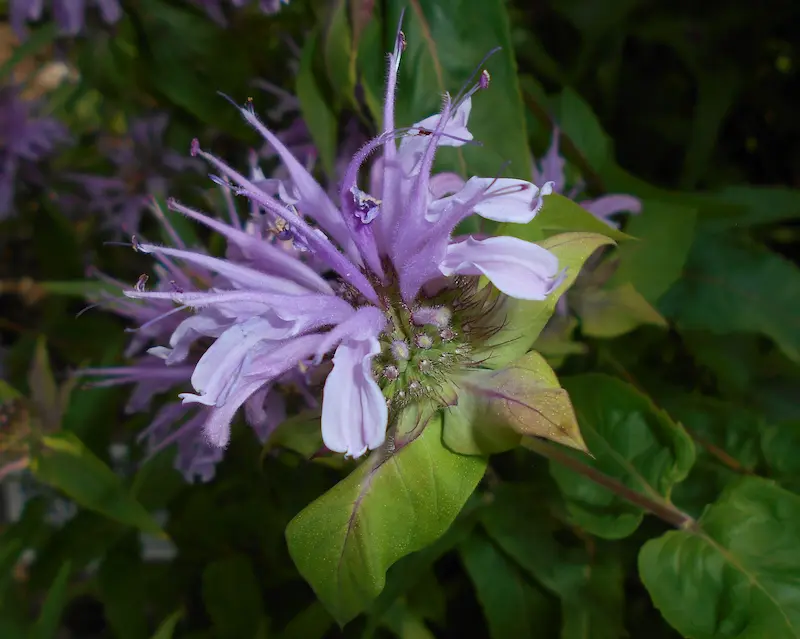Wild Bergamot
Wild Bergamot is an attractive, purple, flowering perennial, which supports many kinds of pollinators, including butterflies and hummingbirds. Its leaves are edible for tea, and flowers in salads.
Wild Bergamot has rich globular heads of fragrant lilac-purple tubular blooms. The flower heads perch on a whorl of beautiful, pinkish bracts and bloom for weeks from mid-summer to early October. You may also flavour tea with the foliage of deep green, distinctively scented leaves. Wild bergamot is a drought-tolerant prairie perennial that spreads by seeds and rhizomes.
Quick Growing Guide
Botanical Name: Monarda fistulosa
Also Called: Purple Beebalm; Wild Horsemint
En français: Monarde fistuleuse
See More Plants in this Botanical Family:
Sun / Shade:
Water: Dry to moist
Height:
Pollinators:
Care:

Credit Salicyna, CC BY-SA 4.0 via Wikimedia Commons
Attracting Pollinators
Wild Bergamot is an important native species for pollinators in the United States and Canada, and is one of the most preferred species for bees, especially bumblebees. The colorful and nectar-rich blooms attract hummingbirds, such as the Ruby-throated hummingbird, butterflies, skippers, and moths, as well as long-tongued bees, such as bumblebees, miner bees, cuckoo bees, and large leaf-cutting bees. Sometimes sweat bees collect pollen, while some wasps steal nectar by perforating the nectar tube. The caterpillars of some moths may feed on the foliage.
Where to Plant
It may be found in fields, meadows, and along boundaries in nature. Wild Bergamot adds colour and contrast to a pollinator garden, herb garden, wild garden, native plant garden, meadow, or naturalised area. It is a good choice in the perennial border.
How to grow wild bergamot
If you start with seeds, divided rhizomes, or cuttings, thoroughly water them after planting. Digging and dividing these perennials every three years is necessary due to their rhizome growth. Bergamots are in the mint family and spread by slender underground rhizomes, but they do not spread widely and are not invasive. These perennials do not spread themselves across the garden, and this plant isn’t any more intrusive than most.
Sowing Seeds
When growing from seed, start them indoors eight to ten weeks before the last frost, or direct seed them outdoors two to three weeks before your last frost in the fall. The ideal soil temperature is 60-70F or 15-21C, and seeds should be sown 6mm (1/4) deep and lightly covered with soil. It would be best if you thinned your plants or space them 45-60 cm (18-24″) apart in the garden. Germination can take 30 days or more.
Spring or fall are both favorable times to plant wild bergamot. Even though it can tolerate less-than-ideal growing conditions, it prefers full sun and rich, well-draining soil. In order to prevent powdery mildew, wild bergamot needs plenty of air circulation, and you should space plants between 17 and 25 inches apart.
Does wild bergamot bloom in the first year?
After the plant has been well established during its first year, leaves can be harvested. As the plant grows annually, more leaves can be harvested. Bee Balm typically does not flower until the second year after planting.
Watering Needs
Wild bergamot thrives in moist soil environments, ensuring an adequate water supply during the primary growing season. To ascertain soil moisture levels, simply insert your finger into the soil. Dry soil should be watered promptly, while during the summer months, watering should be twice weekly if the soil feels dry. During periods of rainfall, water accumulation should be avoided.
Instead of watering the leaves, direct the water to the roots of the plant. Thoroughly water each garden area for 30 seconds using a hose pipe to ensure that the wild bergamot receives sufficient hydration. A lack of adequate water can lead to wilting and shrinking of the leaves. Regular watering is essential to prevent this issue. However, if the leaves droop due to overwatering, it is advisable to reduce the frequency of watering.
Does wild bergamot make good tea?
Wild bergamot flowers exhibit tube-shaped petals, while the green leaves of bergamot plants possess a slight fuzziness and vibrant colour. Notably, the leaves of bergamot plants emit distinct lemon and mint aromas. The beneficial tea brewed from wild bergamot not only tastes delectable but also effectively combats colds and the flu. Its availability during the winter season proves particularly advantageous.
Caring for Wild Bergamot
The optimal growing conditions for Wild Bergamot are characterized by well-drained, dry to medium-moist soils in full sun to partial shade. It exhibits resilience to somewhat poor soils and occasional drought. Adequate air circulation is essential for its health. Additionally, it is susceptible to powdery mildew, so it is advisable to maintain adequate space around the plant and provide watering to the base of the stems. Regular deadheading of flowers can extend the plant’s summer bloom. The plant has a tendency to self-seed.







Leave a Reply
You must be logged in to post a comment.